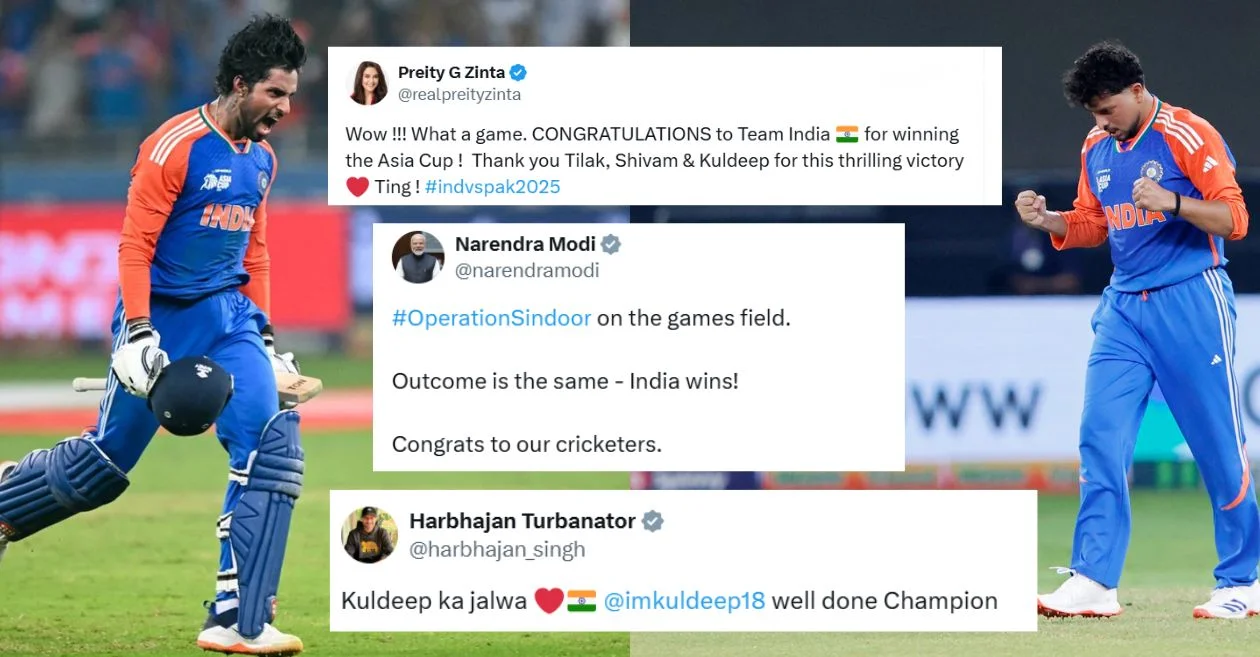The Dubai International Cricket Stadium turned into a cauldron of emotions on September 28, 2025, as arch-rivals India and Pakistan locked horns in yet another unforgettable finale. Amid deafening roars from the stands and millions glued to their screens worldwide, India scripted a stunning five-wicket win to lift their ninth Asia Cup title, reaffirming their dominance in continental cricket.
It was a contest that had everything—nerve, skill, passion, and an undercurrent of history. While Kuldeep Yadav’s magical spell put India in control, Tilak Varma’s nerveless innings sealed the chase, etching both their names into Asia Cup folklore.
Setting the Stage: A Rivalry Like No Other
The build-up to the Asia Cup 2025 Final was as intense as the match itself. India had stormed into the final unbeaten, while Pakistan, recovering from a shaky Super Four stage, found their rhythm in time to set up the dream finale.
This was not just another cricket match. It was the culmination of a rivalry steeped in decades of history, passion, and national pride. Every ball bowled and every run scored felt magnified under the weight of expectation.
India’s Bowlers Lay the Foundation
Kuldeep Yadav Spins a Web
With Pakistan opting to bat first, India entrusted the new ball to Jasprit Bumrah and Hardik Pandya. The early overs were cautious but competitive as Pakistan’s openers Sahibzada Farhan and Fakhar Zaman sought to build a platform. But India’s bowling depth soon took control.
The star of the show was undoubtedly Kuldeep Yadav, India’s premier spinner who has made a habit of rising to big occasions. Introduced in the sixth over, Kuldeep immediately brought the middle overs alive. His spell read like a highlight reel:
-
Fakhar Zaman (18) was deceived by flight and beaten on the inside edge, stumped smartly by Sanju Samson.
-
Saim Ayub (14) tried to break the shackles but top-edged a wrong’un straight to long-on.
-
Shaheen Afridi (2), sent up as a pinch-hitter, became his third victim after misreading a classic chinaman delivery.
-
The pressure culminated in the dismissal of Mohammad Haris (12), who attempted a slog sweep only to find deep midwicket.
Kuldeep finished with match-defining figures of 4/30 in four overs, conceding just 7.50 per over in a high-stakes T20 final. His subtle variations—mixing flight, pace, and angles—left Pakistan’s batters second-guessing.
Pakistan’s Middle-Order Collapse
Pakistan had looked solid at 113/1 in the 13th over, thanks to a resilient 57 from Sahibzada Farhan and 46 from Fakhar Zaman. But once Kuldeep broke the stand, the innings unraveled dramatically. From 126/4, Pakistan lost their last six wickets for just 20 runs.
Supporting Kuldeep were Bumrah (2/26) and Axar Patel (1/20), who applied relentless pressure at the other end. Even Hardik Pandya, who bowled just one over due to cramps, contributed with early swing to keep Pakistan guessing.
By the end of their innings, Pakistan were bowled out for 146 in 19.1 overs, a total that looked below par but still enough to test India under final-match pressure.
India’s Rocky Start to the Chase
The chase of 147 began under a haze of tension. Abhishek Sharma, India’s breakout star of the tournament, fell for just 5, mistiming a drive straight to cover. Soon after, Shubman Gill (12) edged a rising delivery from Haris Rauf, and skipper Suryakumar Yadav (1) perished to a loose cut shot.
At 20/3 inside the powerplay, the Dubai crowd erupted. Pakistan sensed a turnaround. Haris Rauf, Abrar Ahmed, and Faheem Ashraf celebrated every dot ball as if it were a wicket.
But from the chaos emerged a calm figure—Tilak Varma.
Tilak Varma: Calm Amid the Storm
Building the Innings
Tilak’s unbeaten 69 off 53 balls was a masterclass in composure and calculation. When he walked in, India were teetering at 20/3, the scoreboard pressure mounting with every delivery. Yet Tilak didn’t panic.
He began by rotating strike, neutralizing Pakistan’s spinners with deft footwork. Against the seamers, he chose his moments, dispatching anything overpitched to the boundary. His ability to run hard between the wickets—often converting ones into twos—kept the required run rate in check.
The Crucial Partnerships
-
With Sanju Samson (24 off 20): A steadying 50-run stand for the fourth wicket restored India’s chase, blunting Pakistan’s momentum.
-
With Shivam Dube (33 off 22): This 60-run partnership shifted the balance firmly back to India, as Dube’s power-hitting allowed Tilak to play anchor.
Even as wickets fell around him, Tilak remained unfazed. He took calculated risks, lofting Faheem Ashraf over long-off and pulling Shaheen Afridi for a crucial six to ease the pressure.
Finishing with Flair
When the equation came down to 6 runs needed off the last over, Tilak stepped up once again. He struck Haris Rauf’s slower ball over midwicket for a towering six, sealing the win with two balls to spare.
As the ball sailed into the stands, Tilak raised his bat briefly, a quiet gesture of triumph that spoke volumes about his temperament. In a game of fluctuating fortunes, he had been India’s rock.
Unsung Heroes and Turning Points
While Kuldeep and Tilak grabbed the headlines, several quieter contributions shaped the final:
-
Shivam Dube’s cameo (33 off 22): His clean hitting in the middle overs kept Pakistan from tightening the noose.
-
Rinku Singh’s boundary finish: With Tilak anchoring, Rinku’s boundary off his first ball ensured India crossed the line without further drama.
-
Fielding Brilliance: India’s sharp catching—particularly Tilak’s diving grab to dismiss Haris Rauf—kept Pakistan from sneaking away with momentum.
Post-Match Scenes: Joy and Reflection
The scenes at the end were a mix of jubilation and introspection. While Indian players hugged and celebrated their ninth Asia Cup triumph, the absence of a traditional trophy presentation (due to the standoff with ACC President Mohsin Naqvi) lent a surreal undertone to the moment.
Yet the players were unfazed. They posed with the Indian flag at the center of the ground, singing the national anthem with fans, creating one of the most iconic images of the tournament.
What This Victory Means for India
A Statement of Depth
This victory was not just about winning another title. It was a statement of India’s bench strength and adaptability.
-
Abhishek Sharma’s emergence as a power-hitter.
-
Tilak Varma’s rise as a finisher in big games.
-
Kuldeep Yadav’s resurgence as a match-winner in ICC-style tournaments.
With the T20 World Cup looming in 2026, India have found a template for success—aggressive starts, a solid middle order, and a versatile bowling attack.
Suryakumar Yadav’s Captaincy
Though he failed with the bat in the final, Suryakumar’s captaincy has drawn praise. His field placements for Kuldeep were bold yet precise, while his rotation of bowlers prevented Pakistan from settling.
Pakistan’s Takeaways
For Pakistan, the defeat will sting. They had India on the ropes early in the chase but failed to sustain pressure. Their batting collapses in crucial moments remain a recurring theme, while the lack of discipline in death bowling allowed India to escape tight spots.
However, bright spots remain—Sahibzada Farhan’s 57 and Haris Rauf’s fiery opening spell showed that the talent pipeline is still strong.
Statistical Highlights of the Final
-
Kuldeep Yadav: 4/30 in 4 overs – his third four-wicket haul in T20Is.
-
Tilak Varma: Unbeaten 69 off 53 – highest score in an Asia Cup T20 final by an Indian debutant.
-
Pakistan’s Collapse: Lost 6 wickets for 20 runs between overs 14 and 19.
-
India’s Ninth Title: Extending their record as the most successful team in Asia Cup history.
Looking Ahead: India’s Golden Generation
India’s Asia Cup 2025 triumph underlines the emergence of a new core of match-winners. With stalwarts like Rohit Sharma and Virat Kohli having transitioned out of the T20 setup, the likes of Abhishek, Tilak, and Rinku are stepping up.
The tournament also confirmed Kuldeep Yadav’s status as India’s premier T20 spinner, a vital asset heading into global tournaments.
A Final for the Ages
The Asia Cup 2025 Final at Dubai had everything—early wickets, middle-order collapses, a nervy chase, and a stunning finish. At the heart of India’s triumph were two standout performers: Kuldeep Yadav, who spun a web around Pakistan’s batting, and Tilak Varma, who anchored the chase with maturity beyond his years.
As the Indian players celebrated their victory—without the trophy but with unbridled passion—they sent a message to the cricketing world: this is a new India, fearless and unrelenting, ready for any challenge.
For fans, the night was another chapter in the timeless India-Pakistan saga, a match that will be remembered not just for the result but for the way it unfolded—a true cricketing classic.
Please check for information on the best betting sites in India – https://selectory.org/best-betting-sites/















